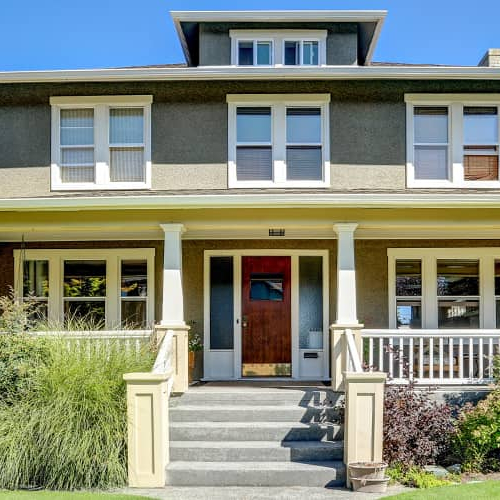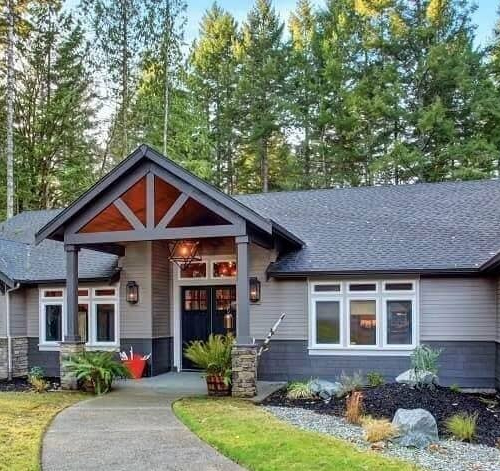Price per square foot: Why it matters and how it's calculated
Jul 19, 2024
•5-minute read
Price per unit is a concept many people deal with on a regular basis, whether they realize it or not. If you can buy a six-pack of paper towels for $5 or an 18-pack for $14, which one is the better deal?
Of course, comparing homes is a little different than comparing multipacks of consumer goods. Understanding a home’s price per square foot – and what you can learn from that number – can be a bit more complex. Here’s what you should know about the price per square foot of a property.
What is price per square foot?
Price per square foot is a metric used in the real estate market to evaluate a home’s value. A lot of factors go into determining the price per square foot of a property. These factors include location, age, condition, number of rooms, lot size, upgrades and renovations.
A high price per square foot doesn’t necessarily mean the home is overpriced, and a low price per square foot doesn’t always mean the home is a steal.
How big is a square foot?
“Square” measurements are equal to the length times the width of a space.
One foot is equal to 12 inches. So, if you have a space that’s 12 inches in length and 12 inches in width, it equals 1 square foot – or 144 square inches.
How to calculate price per square foot
A home’s price per square foot is equal to the listing price divided by the home’s total square footage. For example, if a 1,000-square-foot home is listed for $200,000, the price per square foot is $200:
200,000 ÷ 1,000 = 200
Rental properties typically calculate the price per square foot in a slightly different way. With a rental property, instead you usually calculate the rent per square foot. To do that, take the gross monthly rent divided by the unit’s total square footage. For a multifamily or apartment building, you would take the monthly rent for all the units divided by the total net leasable square footage.
Many online listing sites include the price per square foot in their listings, so you may not even have to worry about calculating this number.
How to determine the average price per square foot in a neighborhood
You can calculate the average price per square foot in a neighborhood by taking the cost per square foot of a certain number of comparable homes, adding those costs up and dividing the total by the number of homes in the area.
You might be better off focusing on the median price per square foot, which is the middle value of the price per square foot for comparable homes in the neighborhood. We’ll go over the median price per square foot later on in the article.
Why does price per square foot matter?
What can the price per square foot tell buyers and sellers about a home’s price and value? While this number alone shows an incomplete view, price per square foot should be used as a starting point.
Home values tend to be similar among comparable homes within the same neighborhood. Comparing the neighborhood’s average price per square foot to the home you want to buy can help see how it measures up to similar homes in the area.
For example, if you’re thinking of buying a home with a higher price per square foot than its very similar next-door neighbor, you might want to ask your real estate agent why that’s the case. It could be that the home you’re looking at has upgrades or features the other home doesn’t.
Despite its overall limitations to offer a full picture, this metric does provide a foundation for the amount of space you’re getting compared to the home price. This can help you feel more confident when making an offer on the house.
Price per square foot example
Let’s take a look at an example of how price per square foot can vary.
Alex and Taylor are next-door neighbors, and they’re both selling their homes.
- Alex is selling their 1,500-square-foot home for $280,000 with a price per square foot of nearly $187.
- Taylor is selling their 2,000-square-foot home for $300,000 with a price per square foot of $150.
Even though Taylor’s home is more expensive overall, isn’t their home the better deal because you’re getting more space for less money? Not necessarily.
Does this mean that Alex’s home is overpriced? Again, not necessarily.
Consider this: Alex, knowing they’d be selling soon, made some updates to their home to boost its value. Taylor didn’t make any improvements to their home, so the interior shows a little wear and tear and has several outdated main systems. In this case, Alex’s home might be the more attractive option for home buyers.
Median price per square foot
The current median price per square foot in the U.S. is around $233, according to May 2024 data from the Federal Reserve Bank of St. Louis. Depending on where you aim to buy a home, the price per square foot of the homes you look at might be significantly higher or lower.
For example, you might see a much higher price per square foot in expensive cities where living space is in high demand. Case in point, it’s not uncommon in New York City to see a price per square foot that’s above $1,000.
What’s the difference between median and average price per square foot?
Median and average are two different types of data sets. Understanding each can help you make informed decisions when comparing property values
Median price per square foot
The median refers to the middle value in a data set. When talking about the median price per square foot, take the price per square foot on a number of comps. Then, look at the number right in the middle – from the house with the lowest price per square foot to the house with the highest. This will give you the median price per square foot for similar homes in that particular area.
Average price per square foot
On the other hand, you can find the average price per square foot is found by adding up the price per square foot of all the comparables and dividing that number by the number of homes being compared.
Unlike the median price per square foot, the average price per square foot can be skewed if some homes in the group of comparables have a price per square foot that’s well above or well below what’s typical for that type of house in that area. Using the median price per square foot can especially be a better metric if there are outliers in the data set of homes that you're looking at.
The bottom line: Price per square foot can help you compare home values
Price per square foot on its own gives you a fairly limited understanding of a home’s value. However, it can give you an idea of the questions to ask about a home you might purchase.
Work closely with your real estate agent to get the full picture of what your prospective home has to offer. Your agent can also point out any red flags they see concerning the quality or condition of the home.
If you’re getting ready to embark on your home buying journey, you can start the mortgage approval process to find out what you qualify for today.

Miranda Crace
Miranda Crace is a Senior Section Editor for the Rocket Companies, bringing a wealth of knowledge about mortgages, personal finance, real estate, and personal loans for over 10 years. Miranda is dedicated to advancing financial literacy and empowering individuals to achieve their financial and homeownership goals. She graduated from Wayne State University where she studied PR Writing, Film Production, and Film Editing. Her creative talents shine through her contributions to the popular video series "Home Lore" and "The Red Desk," which were nominated for the prestigious Shorty Awards. In her spare time, Miranda enjoys traveling, actively engages in the entrepreneurial community, and savors a perfectly brewed cup of coffee.
Related resources

10-minute read
How much house can you afford?
Ever asked, “How much house can I afford?” Determine how much you can spend on a mortgage with help from the Rocket Mortgage home affordability calc...
Read more
5-minute read
How to increase your house value
Upgrading parts of your home is a great way to increase its value. Here are 9 tips about how to get started and finance your renovation projects.
Read more

6-minute read
Appraised value vs. market value: Knowing the difference
Knowing the difference between appraised value vs. market value is key when purchasing a home. Learn more about the role each plays in real estate transactio...
Read more